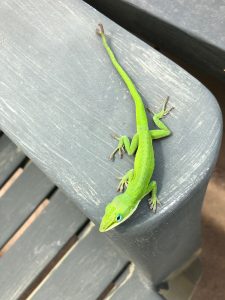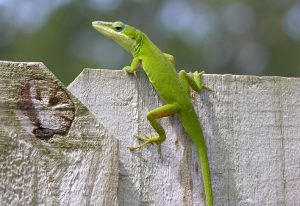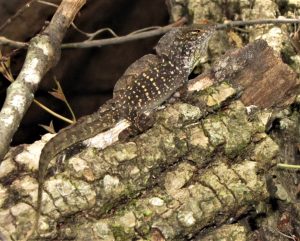There’s plenty of animals you might call “cute”, but lizards usually aren’t among them. However, I’d take exception to that premise when discussing the green anole (Anolis carolinensis). With big blue eyes, brilliant green skin, and flirty males doing push-ups and flexing their dewlaps (the pink throat fan) at you, these little reptiles are more endearing than most.

A green anole–with a slightly forked tail–poses on a deck chair. Photo credit: Carrie Stevenson, UF IFAS Extension
Native to Florida and the deep South, they are competent crawlers, prowlers, and predators. I see them frequently on my office building’s outer stucco walls, running along fences, or skittering up trees. They feed on beetles, termites, ants, worms, spiders, and more. Called the “American chameleon” by some, they possess excellent camouflage, changing their skin rapidly from green to dull brown depending on their backgrounds.
Over the last few years, I—and many biologists—have been concerned about the health of their population. As the invasive Cuban brown anole successfully gained a foothold in north Florida, I saw fewer green anoles and many more of the browns. It has seemed that the greens were losing ground. The invasive species can outcompete the native by eating the green anoles’ young and eggs.
A recent study by a UF PhD candidate found another explanation for why Floridians have seen more brown anoles than green. His study found that the two species have found a way to coexist—the green anoles are moving further up the canopy (an average of 17x higher!), while browns are staying closer to ground level. The green anoles thrive in more natural areas, whereas the brown anoles do well in lower level urban surroundings.
Interestingly, this summer I’ve noticed a resurgence in green anoles and have rarely seen brown ones. I am wondering if our snow days knocked the tropical brown anole populations back, enabling the more temperate greens to recover. Time will tell if the greens have regained their advantage or if it’s only temporary.
One of the best ways to help improve green anole populations is to plant more native vegetation, especially multiple layers, to create a varied canopy. For more information on how to do that, check out our Florida-Friendly Landscaping Guide to Plant Selection and Landscape Design.
- Wax Myrtle–a Native Evergreen - December 26, 2025
- Yucca–A Tough and Versatile Native Plant - November 26, 2025
- Blazing Star - November 6, 2025


